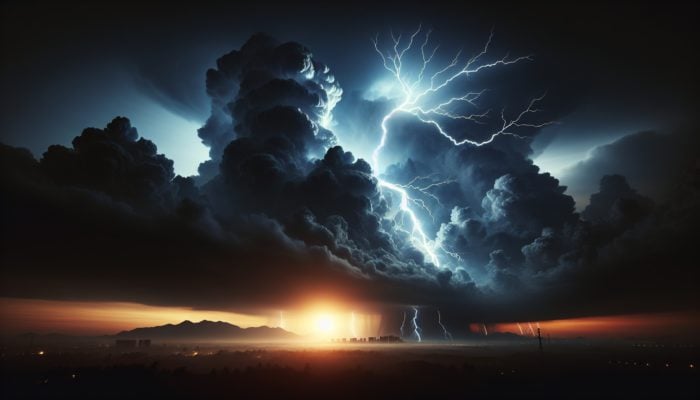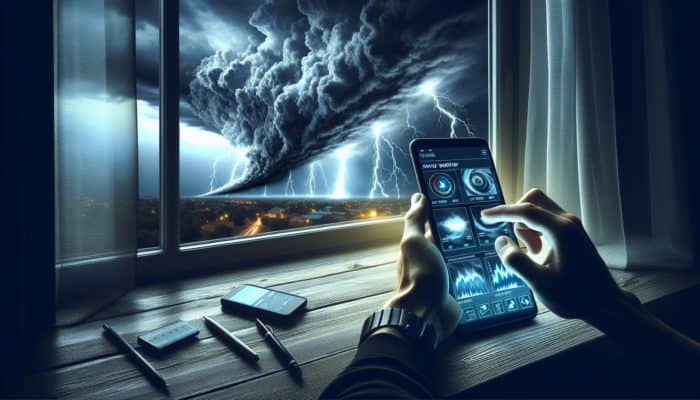Enhancing Your Knowledge of Lightning Strikes for Personal Safety
To effectively protect yourself during thunderstorms, it is essential to comprehend the dynamics of lightning, a breathtaking natural event that can become lethal without warning. Gaining insights into the formation of lightning, the different variations that can occur, and their potential impacts on human beings is vital for anyone aiming to bolster their safety against storm hazards. This understanding empowers individuals to implement critical safety measures, significantly lowering the chances of becoming a victim of this magnificent yet dangerous phenomenon. Being adept at navigating the risks associated with thunderstorms is paramount for ensuring overall safety and well-being.
Uncovering the Science Behind Lightning Formation

Lightning is born from the complex interplay of atmospheric electricity, especially prevalent during thunderstorms. This powerful electrical discharge happens when areas of opposing charges within a cloud or between a cloud and the surface of the earth accumulate sufficient energy to generate a strong electrical current. The underlying scientific principles involve collisions between water droplets and ice particles in the clouds, which result in the separation of electrical charges. As a result, positive charges gather in the upper sections of the cloud, while negative charges cluster at the base, creating the perfect conditions for a lightning strike to occur.
Regions that frequently endure thunderstorms, like tropical climates or specific locales such as Florida, are renowned for their spectacular displays of lightning, often referred to as “heat lightning.” Understanding the meteorological conditions that give rise to lightning is crucial for surviving a lightning strike. Employing meteorological apps and reliable weather forecasts can provide invaluable warnings about impending storms, allowing individuals to take appropriate safety actions before the weather turns threatening. Being proactive in this regard can greatly lessen the risk of encountering dangerous lightning conditions.
Comprehending the Various Types of Lightning Strikes
The realm of lightning encompasses a wide array of types, each associated with distinct dangers and consequences. The four primary categories of lightning strikes include direct strikes, side flashes, Ground currents, and conductor strikes. Each strike type carries its own set of hazards that individuals must be aware of to ensure their safety in stormy conditions.
A direct strike occurs when lightning directly hits a person or object, often resulting in severe injuries or immediate death. In contrast, a side flash happens when lightning strikes a nearby object and then jumps to an individual standing close by. Ground currents can travel across the earth’s surface, affecting individuals who may not be in close proximity to the original strike location but remain within the area. Lastly, conductor strikes are aimed at objects like trees, buildings, or power lines, which can facilitate the flow of electricity.
Being informed about these different types of strikes is vital for anyone who participates in outdoor activities, including hikers, campers, or sports enthusiasts. Understanding the most dangerous forms of lightning can significantly enhance your chances of surviving a lightning strike, allowing you to enjoy outdoor pursuits with greater confidence and safety.
Analyzing the Global Frequency of Lightning Strikes
Lightning strikes occur with a frequency that often surprises many. Statistically, approximately 240,000 lightning strikes happen worldwide every day, amounting to billions on an annual basis. Areas with high thunderstorm activity, such as the Caribbean or Southeast Asia, experience a higher frequency of strikes, whereas other regions may encounter fewer incidents, though they still pose considerable risks. Understanding this frequency is a crucial aspect of evaluating personal safety.
Being aware of the frequency of lightning strikes is essential for self-protection. For outdoor lovers or individuals residing in lightning-prone areas, staying alert and prepared is paramount, especially during peak thunderstorm seasons. Recognizing that lightning is a constant threat allows individuals to make informed decisions about when to seek shelter and how to effectively prepare for storms.
Assessing the Health Consequences of Lightning Strikes on Individuals
The effects of lightning strikes on human beings can be catastrophic. Immediate repercussions include cardiac arrest, severe burns, and neurological damage. Survivors of lightning strikes frequently face long-term health complications, such as memory impairment, chronic pain, and psychological distress. These outcomes can drastically affect one’s quality of life, necessitating ongoing medical care and support.
According to the National Lightning Safety Institute, around 90% of lightning strike victims survive; however, many face significant health challenges in the aftermath. The extent and severity of injuries sustained depend on various factors, including the individual’s proximity to the strike and the pathway the electrical current takes through their body. Acknowledging the potential for severe injury highlights the importance of implementing safety protocols during storms to effectively minimize risks.
Implementing Comprehensive Lightning Safety Guidelines
To mitigate the dangers associated with lightning strikes, it is vital to establish thorough safety protocols. A fundamental guideline is to avoid open fields, tall trees, and bodies of water during thunderstorms since these locations increase exposure to lightning, making individuals more vulnerable to strikes.
On the other hand, seeking refuge inside a robust building or a fully enclosed vehicle offers the highest level of protection. While no location is completely safe during a lightning storm, adhering to these precautions can significantly reduce risks. Awareness and preparedness are your best defenses against the unpredictable nature of lightning, enhancing your ability to respond effectively when storms arise.
Proactively Preparing for Imminent Storms
Preparation plays a crucial role in ensuring safety during thunderstorms. By taking proactive steps, you can significantly lower your chances of being struck by lightning and minimize the risks associated with severe weather conditions. This preparation involves understanding the potential impacts of the storm and implementing appropriate actions to protect yourself and your loved ones.
Staying Informed About Weather Conditions

Keeping abreast of weather conditions is essential for anyone aiming to shield themselves from lightning strikes. Utilizing trusted weather applications or services can deliver real-time updates on approaching storms and potential lightning threats. Many apps now feature alerts that notify users when severe weather is imminent, providing sufficient time to seek shelter and take necessary precautions.
In addition to employing apps, monitoring local weather reports and radar images to track storm movements closely is wise. It is also advisable to have a backup communication method ready in case of power outages. Remaining vigilant and informed can make a significant difference in ensuring safety when storms suddenly materialize.
Developing a Thorough Lightning Safety Strategy
Creating a comprehensive safety plan is crucial for effectively minimizing exposure to lightning risks. Your plan should encompass specific indoor and outdoor safety measures to be enacted during a lightning storm.
In outdoor situations, identify safe locations for shelter during storms, such as nearby buildings or vehicles that provide adequate protection. Indoors, make sure that all family members are aware of the safest areas to seek refuge. Regular discussions with family can reinforce these plans, ensuring that everyone understands the importance of finding protection from lightning.
A well-structured safety plan serves as a roadmap, guiding individuals and families through the chaos of a storm and significantly increasing their chances of surviving a lightning strike.
Investing in Essential Lightning Safety Gear
Equipping yourself with vital safety equipment can substantially lower risks during thunderstorms. Items such as rubber-soled shoes offer a non-conductive barrier, while non-conductive umbrellas can provide protection against direct strikes. Investing in high-quality gear not only enhances safety but also fosters a culture of preparedness within your household.
Moreover, assembling personal emergency kits that include critical items such as flashlights, batteries, and first aid supplies ensures you are ready to face any challenges that may arise during a storm. Being well-equipped with the proper tools not only guarantees safety but also enhances your peace of mind when storms are on the horizon.
Securing Outdoor Items Before Storms Arrive
Loose outdoor items can pose significant threats during storms, particularly when strong winds accompany lightning. Taking the time to secure or store items like garden furniture, decorations, and tools can prevent these objects from becoming dangerous projectiles during inclement weather.
A well-maintained and organized yard not only enhances safety but also contributes to the visual appeal of your property. Make it a routine to inspect your outdoor spaces before storms, ensuring that everything is safely stowed away. This proactive step enhances your safety unexpectedly and prepares you for any weather-related challenges that may arise.
Establishing Indoor Safety Protocols During Thunderstorms
Once storms strike, knowing how to stay safe indoors can significantly reduce the risks associated with lightning strikes. Proper awareness and precautionary measures can help protect your home and loved ones during turbulent weather conditions.
Refraining from Using Conductive Appliances During Thunderstorms
During a lightning storm, it is critical to avoid conductive appliances. Many electrical devices can act as conduits for electricity if a nearby strike occurs. Plumbing also presents a risk, as water pipes can conduct electricity, increasing the likelihood of injury.
Maintaining a safe distance from these hazards can dramatically lower your risk of injury during a storm. Educate all household members about the dangers of using electronic devices or touching metal fixtures during thunderstorms, ensuring everyone understands the importance of exercising caution during such events.
Identifying Safe Spaces Inside Your Home
Recognizing safe areas within your home is a vital aspect of indoor safety during thunderstorms. Seek shelter in buildings equipped with lightning rods or sturdy structures that can withstand electrical impacts. Areas like basements or interior rooms, away from windows, provide better protection during storms.
Avoiding open spaces and windows minimizes the risk of injury from stray electrical currents or flying debris. The more knowledgeable you are about safe locations, the better your chances of surviving a lightning strike and ensuring the safety of your family during severe weather events.
Safeguarding Your Electronics from Lightning Damage
Lightning can cause significant damage to electronic devices, resulting in irreparable harm due to power surges. Unplugging devices during storms is a simple yet effective measure to protect your electronics from potential damage.
Consider investing in surge protectors for sensitive equipment, such as computers or televisions, to add an extra layer of defense. Protecting your electronics not only preserves your finances but also ensures that you remain connected and informed during severe weather conditions, enabling better preparedness and response.
Preparing a Comprehensive Emergency Kit for Storms
Assembling a well-rounded emergency kit is an essential preparatory measure for storms. Ensure your kit is stocked with critical items, such as flashlights, batteries, a first aid kit, and bottled water. Being prepared for power outages and emergencies during storms guarantees that you are equipped to handle any situation that may arise.
Regularly check your emergency kit to replenish outdated items and maintain its readiness. A well-stocked kit can serve as a lifeline during a storm, enhancing your chances of surviving a lightning strike and ensuring safety within your home.
Educating Household Members on Lightning Safety Protocols
Education is an invaluable asset in lightning safety. Teach everyone in your home about indoor safety protocols and the significance of adhering to them during thunderstorms.
Organize family discussions or practice drills to reinforce knowledge about the actions to take when storms strike. The more informed your household members are, the better equipped you will all be to tackle the challenges posed by severe weather together, enhancing your overall safety.
Implementing Effective Outdoor Safety Strategies During Storms
As storms approach, outdoor safety becomes increasingly important. Knowing how to respond when caught outside can significantly boost your chances of surviving a lightning strike and maintaining your well-being during turbulent weather.
Rapidly Finding Shelter During a Storm
In a lightning storm, swiftly locating shelter is crucial. Low-lying areas and dense forests can provide temporary refuge, reducing your exposure to lightning. Always seek buildings or vehicles when possible, as these structures offer far superior protection compared to remaining exposed to the elements.
Having a clear plan regarding where to find shelter in your vicinity is vital. Whether hiking a trail or enjoying a day at the beach, knowing your options can be lifesaving in the event of an unexpected storm.
Maintaining Distance from Tall Structures
Keeping a safe distance from tall objects, such as trees or telephone poles, is a critical safety measure during thunderstorms. These structures are more likely to attract lightning, increasing your risk if you are nearby.
While outdoors, be conscious of your surroundings and avoid areas where tall objects are present. Instead, opt for open fields or lower terrains, as these positions can diminish your chances of being struck directly by lightning, thereby enhancing your safety.
Practicing Safe Body Positioning Outdoors
If you find yourself outdoors during a lightning storm and cannot access shelter, your body positioning can significantly influence your safety. Crouching low to the ground with minimal contact can help mitigate the risk of ground current strikes.
Keeping your feet close together and squatting low minimizes your contact with the ground. This positioning lowers your overall profile while also reducing the chances of electrical currents traveling through your body during a storm.
Taking Appropriate Actions Following a Lightning Strike
The moments following a lightning strike can be disorienting and overwhelming. Knowing the right steps to take immediately can be crucial for ensuring safety and well-being.
Evaluating Personal Injury After a Lightning Strike
After a lightning strike, assessing personal injury is a critical first step. Check yourself and those around you for burns, signs of cardiac arrest, or neurological symptoms. If anyone is unresponsive, administering CPR and seeking immediate medical assistance is essential.
Recognizing the symptoms of injury can be difficult, especially in the chaotic aftermath of a strike. Remain calm and focus on providing first aid to those affected while waiting for emergency services, as your actions can be pivotal in ensuring their survival.
Providing Assistance to Others After a Strike
If it is safe to do so, help others who may have been affected by lightning. Prioritize those in urgent need of care, such as individuals experiencing cardiac arrest. Call emergency services immediately, providing clear details about the situation to ensure prompt assistance.
Offering help can be a vital aspect of surviving a lightning strike. Your actions could save a life, making it critical to remain composed and act swiftly in emergencies, as your prompt response can significantly impact the outcome.
Continuing Safety Measures After a Lightning Strike
Following a lightning strike, it is crucial to remain vigilant, as storms can produce multiple strikes. Stay sheltered until the storm has fully passed. Keep monitoring weather alerts for any changes in conditions or further updates. Ensure that your emergency kit is easily accessible and ready for use. Staying alert guarantees that you are prepared for any unforeseen circumstances that may arise after a storm, helping you navigate potential dangers effectively.
Understanding Long-Term Health Considerations for Lightning Strike Survivors
Surviving a lightning strike is a transformative experience, and the path to recovery can be intricate and ongoing. The aftermath often presents numerous challenges that survivors must confront.
Identifying Potential Long-Term Health Implications
Individuals who have endured lightning strikes may face various long-term health effects, including memory loss, chronic pain, and psychological trauma. The physical consequences of a strike can lead to debilitating conditions requiring extensive rehabilitation and continuous care, which can be both challenging and exhausting.
Recognizing these potential health impacts enables survivors and their families to seek appropriate medical treatment and support. Understanding that the recovery process may be lengthy prepares individuals with the mental resilience needed to confront ongoing challenges, ensuring they have access to the necessary resources for their long-term well-being.
The Importance of Ongoing Medical Follow-Ups
Regular medical check-ups are vital for anyone who has survived a lightning strike. Continuous assessments help monitor and manage any lasting effects from the strike, ensuring that complications are addressed promptly and effectively.
Engaging in open discussions with healthcare professionals about experiences and symptoms can provide valuable insights and guidance for managing long-term health considerations. A proactive approach to healthcare can significantly enhance the quality of life for survivors post-strike, ensuring they receive the necessary care.
Seeking Support for Mental Health Challenges
The emotional and psychological impact of surviving a lightning strike can be profound and long-lasting. Survivors may grapple with anxiety, depression, or post-traumatic stress disorder (PTSD). Seeking therapy or counseling can provide a safe environment for individuals to process their experiences and emotions, enabling them to navigate their trauma in a supportive setting.
Connecting with support groups or mental health professionals familiar with trauma can be immensely beneficial. These resources foster resilience and equip survivors with the tools necessary to address the mental health complexities that may surface following a lightning strike, aiding in their overall recovery.
Empowering Communities Through Lightning Safety Education
Utilizing Personal Experiences to Raise Awareness and Educate Others
Sharing personal experiences related to the dangers of lightning and the safety measures that can be taken can significantly impact educating others. Your stories can enhance awareness of the risks associated with storms and underscore the importance of preparedness.
Consider speaking at community events, schools, or local organizations to share your insights. Your lived experiences can empower others to take lightning safety seriously, potentially saving lives in the future by encouraging proactive measures.
Promoting Lightning Safety Awareness in Local Communities
Encouraging communities to adopt safety protocols and educational programs regarding lightning risks is vital for fostering a culture of awareness and preparedness. Advocate for local initiatives that focus on lightning safety education within schools and community centers, emphasizing the significance of understanding the dangers posed by thunderstorms.
Promoting safety awareness through social media platforms or community outreach can effectively reach a broad audience, reinforcing the necessity of taking lightning risks seriously and enhancing collective safety.
Utilizing Educational Resources for Community Safety Enhancement
Take advantage of available educational resources to boost your understanding and awareness of lightning safety. Numerous organizations offer materials, guides, and online courses focused on lightning safety, which can be invaluable for community education.
Distributing these resources within your community can help inform individuals about the risks associated with thunderstorms, empowering them to take proactive safety measures. Leveraging technology to share information makes it accessible to a wider audience, further enhancing public safety.
Addressing Common Inquiries Regarding Lightning Safety
What steps should I take if I see lightning?
Seek shelter immediately in a substantial building or vehicle. Avoid open areas, tall objects, and bodies of water to minimize risk.
How can I determine if a storm is approaching?
Monitor weather apps or services for alerts regarding thunderstorms. Pay attention to darkening skies and increasing winds, which often indicate an imminent storm.
Can lightning strike the same location multiple times?
Yes, lightning can and often does strike the same spot multiple times, particularly in tall structures such as skyscrapers and radio towers, which are more susceptible to strikes.
Is it safe to use my phone during a storm?
Avoid using wired phones during a lightning storm, as they can pose risks. Cell phones are generally safer, but it's still best to refrain from using conductive devices whenever possible.
What symptoms indicate a lightning strike injury?
Signs may include burns, confusion, irregular heartbeats, and loss of consciousness. Immediate medical attention is necessary if you suspect an injury from a lightning strike.
Is swimming safe during a lightning storm?
Swimming during a lightning storm is extremely dangerous, as water conducts electricity, significantly increasing the risk of being struck by lightning.
What should I include in my emergency kit?
Your emergency kit should contain flashlights, batteries, a first aid kit, bottled water, and non-perishable food items to ensure readiness during emergencies.
How can I prepare my outdoor space for a storm?
Secure or bring in any loose items that could become hazardous during high winds, ensuring that your yard is free of debris and safely stored away.
What is the safest place to be during a lightning storm?
The safest place during a lightning storm is indoors, in a sturdy building or a fully enclosed vehicle that protects from strikes.
What are the survival chances after being struck by lightning?
Approximately 90% of individuals struck by lightning survive; however, many may encounter severe long-term health issues. Immediate medical attention is crucial for all victims.
Explore more with us on X!
The post Surviving a Lightning Strike: Essential Tips appeared first on Survival Bite.
The Article Essential Tips for Surviving a Lightning Strike Was Found On https://limitsofstrategy.com

